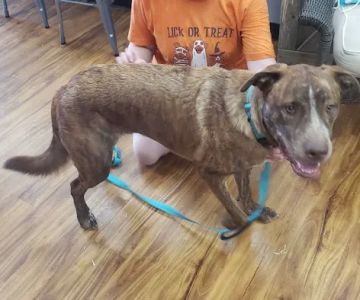Training Your Dog to Be Comfortable with New Environments
As a dog owner, one of the most rewarding challenges is helping your dog feel comfortable and confident in new environments. Whether it's a new home, a trip to the vet, or a visit to a bustling park, dogs often find unfamiliar places overwhelming. But with the right training techniques and a little patience, you can help your dog adjust and thrive in any new environment. In this article, I will share practical tips and methods that worked for me while training my own dog, and how you can apply them to ensure your pet feels safe and relaxed no matter where you are.
1. Understand Your Dog’s Personality and Anxiety Triggers
Before embarking on any training, it's important to recognize that every dog is unique. Some dogs are naturally more confident and adapt quickly to new environments, while others may feel anxious or scared. I’ve noticed this with my own dog – a rescue who needed extra time to feel at ease in new spaces.
Pay attention to your dog’s body language. Does your dog become visibly stressed, drool excessively, or start panting when entering a new environment? These are common signs of anxiety. Identifying the triggers—such as loud noises, crowded areas, or unfamiliar scents—can help you tailor your training approach and gradually expose your dog to those stimuli in a controlled way.
2. Start Small with Low-Stress Locations
When I first began training my dog to get comfortable in new places, I didn’t take him to overwhelming environments like crowded parks or busy streets right away. Instead, we started small. For example, we took short walks around quieter areas, allowing him to explore his surroundings at his own pace.
Choose less overwhelming environments for your dog’s initial exposure. A quiet neighborhood or an empty dog park can be an excellent starting point. Gradually increase the level of stimulation as your dog becomes more comfortable, ensuring each experience is positive and stress-free. With time, your dog will begin to associate new environments with safety and fun.
3. Use Positive Reinforcement to Encourage Confidence
Positive reinforcement is a powerful tool in dog training. For my dog, I found that offering treats, praise, and petting whenever he was calm in a new environment made a world of difference. By rewarding calm behavior, I helped him learn that new environments aren’t something to fear.
Each time your dog remains calm in a new place, reward them immediately. This builds a positive association with the environment, helping them realize that being calm in unfamiliar surroundings leads to good things. Whether it’s a treat, a favorite toy, or verbal praise, consistent reinforcement is key to helping your dog feel more secure.
4. Gradual Exposure to New Environments
Just as with humans, dogs benefit from gradual exposure to new experiences. Jumping straight into a high-stress environment can overwhelm a dog and cause them to associate new places with fear or anxiety. This is something I learned after initially rushing my dog into environments that were too stimulating.
Instead, I learned to take it slow. Begin with less distracting environments and work your way up. For example, you could start by taking your dog to a local park when it’s not too busy, and then gradually increase exposure to busier times. Over time, your dog will become more comfortable as they experience new places without being overwhelmed.
5. Create a Safe Zone in New Environments
Another technique I found helpful was creating a “safe zone” for my dog in new environments. When visiting unfamiliar places like friends’ houses or pet-friendly cafes, I would bring his bed or blanket along to give him something familiar to settle into.
Having a safe space, such as a crate or a specific blanket, can provide your dog with comfort and security in unfamiliar environments. This can help them feel more relaxed and less stressed. Over time, they will start to associate these new locations with their safe place, making transitions smoother.
6. Socialization with Other Dogs and People
Socializing your dog with other dogs and people is essential for building their confidence. When I took my dog to new environments like the dog park, I made sure to introduce him to calm, friendly dogs first. This helped him feel more comfortable around other animals and reduced his fear of crowds.
Gradually increasing exposure to other dogs and people in a controlled and positive manner helps your dog become less anxious around new faces and animals. Always monitor your dog’s behavior and ensure the environment remains positive and not overwhelming.
7. Be Patient and Consistent
Training a dog to feel comfortable in new environments takes time, and consistency is crucial. I learned that being patient with my dog and repeating positive experiences helped him grow more confident with each new environment we encountered.
It’s important to remember that your dog may have setbacks, especially if they’ve experienced trauma or anxiety in the past. Stay patient, and don’t rush the process. Every small step forward is progress. Consistency in training and exposure to new experiences is key to success.
8. Seek Professional Help if Needed
While many dogs can adjust to new environments with some training and patience, some may require professional help. If your dog’s anxiety is severe or persistent, it may be beneficial to consult a professional dog trainer or behaviorist. These experts can provide tailored advice and strategies to help your dog overcome their fears.
In my experience, a good trainer can make a significant difference, especially when working with dogs that have specific phobias or behavioral challenges. Don’t hesitate to seek expert assistance if your dog’s anxiety is affecting their quality of life or yours.
By following these steps and maintaining a calm, supportive approach, you can help your dog feel more comfortable in new environments. It’s a journey that requires patience and commitment, but the rewards are worth it. A confident, relaxed dog will enjoy life more fully, and so will you!











